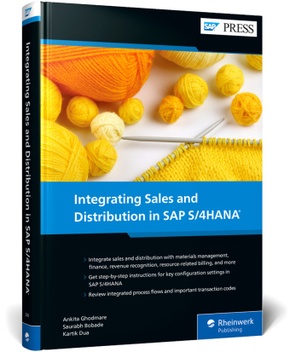Integrating Sales and Distribution in SAP S/4HANA
| Verlag | Rheinwerk Verlag |
| Auflage | 2023 |
| Seiten | 580 |
| Format | 19,0 x 4,0 x 26,9 cm |
| Gewicht | 1334 g |
| Artikeltyp | Englisches Buch |
| Reihe | SAP PRESS Englisch |
| EAN | 9781493223299 |
| Bestell-Nr | 49322329UA |
To run sales and distribution smoothly in SAP S/4HANA, you need to manage integration points with other lines of business. Learn how to set them up with this guide to SD integration! Start by assessing the organizational structure and master data shared by sales and peripheral processes. Then follow step-by-step instructions to configure each sales integration point with materials management, finance, revenue recognition, billing, and production planning. A seamlessly integrated SD system awaits!
In this book, you'll learn about:
a. Organizational and Master Data
Build the foundation of your integrated SD system. Learn about the organizational structures for sales and distribution and adjacent lines of business in SAP S/4HANA; then create shared business partner roles and material master data.
b. Finance Integration Points
Integrate sales and distribution with intersecting finance business processes. Follow step-by-step instructions to configure integration points like credit management, profitability analysis, revenue recognition, resource-related billing, and more.
c. Logistics Integration Points
Configure integration between sales and distribution and your logistics processes. Set up integration points such as availability checks, stock transfer orders, inventory management, production planning, and transfer of requirements.
Highlights include:
1) Integration points
2) Cross-functional processes
3) Organizational structure
4) Master data
5) Materials management
6) Finance
7) Revenue recognition
8) Resource-related billing
9) Production planning
10) Configuration
Inhaltsverzeichnis:
... Preface ... 13
... Objective of This Book ... 13
... Target Audience ... 14
... How to Read This Book ... 14
... Acknowledgments ... 16
1 ... Integrated Sales ... 19
1.1 ... Sales in an Enterprise Resource Planning System ... 19
1.2 ... Sales and Finance ... 24
1.3 ... Sales and Supply Chain Management ... 28
1.4 ... Summary ... 36
2 ... The SAP Organizational Structure ... 37
2.1 ... Sales and Distribution ... 38
2.2 ... Materials Management ... 46
2.3 ... Finance ... 52
2.4 ... Project System ... 77
2.5 ... Peripheral Systems ... 81
2.6 ... Summary ... 85
3 ... Master Data ... 87
3.1 ... Business Partner ... 87
3.2 ... Material Master ... 121
3.3 ... Summary ... 148
4 ... Materials Management ... 149
4.1 ... Available-to-Promise ... 149
4.2 ... Stock Transport Order ... 178
4.3 ... General Ledger Account Deter mination in Deliveries ... 206
4.4 ... Third-Party Processing ... 221
4.5 ... Inventory Management ... 242
4.6 ... Summary ... 260
5 ... Finance ... 261
5.1 ... Pricing and Taxation ... 261
5.2 ... Account Determination in Billing ... 296
5.3 ... Credit Management ... 306
5.4 ... Profitability Analysis ... 327
5.5 ... Intercompany Billing ... 345
5.6 ... Summary ... 359
6 ... Revenue Recognition ... 361
6.1 ... What Is Revenue Recognition? ... 361
6.2 ... SAP Revenue Accounting and Reporting ... 369
6.3 ... Optimized Contract Management ... 461
6.4 ... Summary ... 468
7 ... Resource-Related Billing ... 469
7.1 ... Project-Based Billing ... 470
7.2 ... Dynamic Item Processing ... 483
7.3 ... Time Sheets Using Cross-Application Time Sheet ... 497
7.4 ... Expenses Using SAP Concur ... 505
7.5 ... End-to-End Integration ... 510
7.6 . .. Summary ... 514
8 ... Production Planning ... 515
8.1 ... Material Requirements Planning ... 515
8.2 ... Transfer of Requirements ... 523
8.3 ... Variant Configuration ... 531
8.4 ... Make to Order ... 539
8.5 ... Summary ... 546
A ... Electronic Data Interchange ... 547
A.1 ... Benefits of Electronic Data Interchange ... 548
A.2 ... Electronic Data Interchange in Sales and Distribution ... 548
A.3 ... Types, Tables, and Transactions ... 561
B ... The Authors ... 563
... Index ... 565

